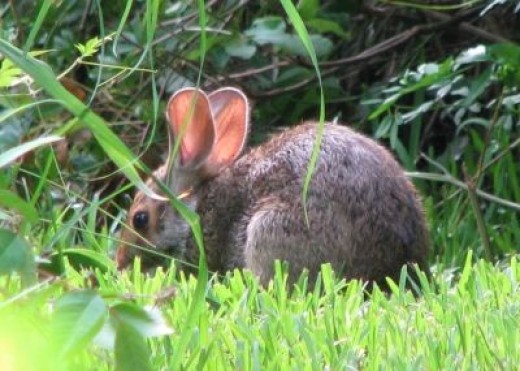

Their large ears allow them to hear very well and also cool off in high temperature. Rabbits differ from hares in that hares are both with fur and able to move and see shortly after birth. This species is the ancestor of all 80 varieties of domestic rabbits. Rabbits have shorter ears and smaller, less powerful hind legs than hares. The doe's nest will consist of grass, hay or straw lined with the doe's own plucked fur and each doe keeps within her own territory in the warren.Domestic individuals may be larger than wild European rabbits. The 'stop' can be a separately dug burrow, which may eventually become starting point of a new community. The doe will build her nest in a separate burrow in the warren, called a 'stop'. Spraying urine is common sexual behaviour.

Courtship behaviour involves licking, sniffing, with the buck following the doe. Courtship and mating are very brief, lasting less than a minute. In Australia & New Zealand breeding season is late July to late January. The breeding season for most rabbits lasts around 9 months, starting January/February to October, with Spring and Summer being the main reproductive periods.

A wild rabbit's predators include foxes, badgers, stoats, weasels, buzzards, cats and of course man. This prolific breeding is usually balanced by many deaths caused by predators, disease, road traffic, shooting and trapping. In one year, a doe can produce more than 20 offspring with many of these breeding themselves, when only a few months old.

Rabbits have a very rapid reproductive rate. These adult wild rabbits have been alerted to some possible form of danger Them to eat and to bite in order to escape a struggle. They survive predators byīurrowing, hopping away in a zig- zag motion, and, if captured,ĭelivering powerful kicks with their hind legs. Threat, a rabbit may freeze and observe, then warn others in the warren The flash of white from under its tail as it runs for its burrowĪlso acts as an alarm signal. If a rabbit spots danger, it will warn others by thumping with a hindįoot. Wide field of vision and can naturally see over a wide area including a Rabbit is a prey animal and has many enemies. Wild rabbits keep themselves clean by washing regularly and grooming, using their teeth, tongue and claws. You may see areas where the vegetation is shorter than surrounding areas. Rabbits graze and feed close to their warren. Whether its dawn, dusk or even during the day, this adult rabbit will be grazing close to its warren Usually only coming out of their burrows at dawn and dusk, wild rabbits can, however, be spotted in broad daylight on warm, sunny days, or in undisturbed places. Rabbits then produce hard, pellet-like droppings above ground. Much of the day is spent underground, resting and passing soft, darkĭroppings which are eaten to extract more nourishment from them. They do, however, mix happily with other subordinate rabbits. Subordinate or lesser ranking rabbits do not establish a territory and will be warned off if they venture into the territory of a dominant rabbit. Dominant bucks run up and down boundary lines marking their territory by depositing droppings, scratching out shallow scrapes or rubbing their chin in the ground, marking their area with scent from their glands. Dominant rabbits are the most successful at breeding. Usually a dominant doe within the colony will fight other does for the best nesting site. The warren is dug with interconnecting tunnels running off in all directions containing living quarters, nesting areas, bolt runs and emergency exits. The warren can be 3 meters in depth and cover a large area with many entrances. Rabbits, being sociable animals, live in groups or colonies, in burrow systems known as warrens. Empty cliff burrows are often taken over by nesting puffins and shearwaters. Their natural habitats include woods, meadows, forests, farmland, grassland, moorlands, salt marshes, embankments, sand dunes and cliffs. Rabbit's can live almost anywhere they are able to dig burrows. Most Wild rabbits live for less than one year.


 0 kommentar(er)
0 kommentar(er)
